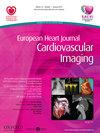The predictive value of left atrial expansion index and left atrial contractile strain in younger hypertensive patients with atrial fibrillation
引用次数: 0
Abstract
Type of funding sources: None. Arterial hypertension (HTN) is the most prevalent risk factor for Atrial fibrillation (AF) through structural and functional changes of the left atrium. Paroxysmal AF is mainly asymptomatic and silent forms in patients with HTN are associated with thromboembolic complications. However, prompt identification of HTN patients at risk for AF may be strategic for preventing purposes. To assess sensitive and predictive parameters for AF onset in HTN patients using two-dimensional (2D) conventional and speckle tracking echocardiography of the left atrium (LA) and left ventricle (LV). A total of 165 consecutive patients were screened for participation in the study. Only 80 patients met the inclusion criteria ( age below 60 years; with well controlled HTN or HTN with AF; without concomitant disease or other risk factors for AF).They were separated in two groups: 43 with HTN and 37 patients with AF and HTN. All patients underwent standard 2D echocardiography with volumetric and Speckle tracking analysis for assessment of: LV global longitudinal strain; LA total ( LATEF), passive ( LAPEF), active (LAAEF) emptying fractions; LA stiffness and expansion index; LA - reservoir (LASr), conduit (LAScd) and contractile (LASct) strain. There were statistically significant differences between patents with HTN and HTN with AF group in: LASr (30.88 ± 3.99% vs. 27.89 ± 8.21 %, p= 0.049), LASct (-17.64 ± 2.04% vs. -14.4 ± 6.74 %, p= 0.007) and LA expansion index (122 ± 42% vs. 174 ± 115%; p = 0.014). There were no significant differences in other LV and LA structural and functional indices. Multiple regression analysis demonstrated that LASct ( B= - 0.043’ p= 0.001; 95%CI -0.063- -0.023) and expansion index (B= 0.023; p= 0.001, 95%CI 0.117- 0.349) are independent predictors of AF in hypertensive patients. Preserved LA compliance and contractile function are essential for maintenance of sinus rhythm in younger HTN patients. These findings could be used for prediction of cardiovascular events and preventing AF onset in younger hypertensive population with a huge social impact.左房扩张指数和左房收缩应变对年轻高血压合并心房颤动的预测价值
资金来源类型:无。动脉高压(HTN)是心房颤动(AF)最常见的危险因素,通过左心房的结构和功能改变。阵发性房颤主要是无症状的,HTN患者的无症状形式与血栓栓塞并发症有关。然而,及时识别有AF风险的HTN患者对于预防目的可能具有战略意义。利用左心房(LA)和左心室(LV)二维常规超声心动图和斑点跟踪超声心动图评估HTN患者AF发作的敏感性和预测性参数。共有165名连续患者被筛选参与该研究。只有80例患者符合纳入标准(年龄小于60岁;控制良好的HTN或HTN与AF;无伴发疾病或其他房颤危险因素)。将患者分为两组:HTN组43例,AF合并HTN组37例。所有患者均接受标准二维超声心动图,并进行容积和斑点跟踪分析,以评估:左室整体纵向应变;LA总(LATEF)、被动(LAPEF)、主动(LAAEF)排空分数;LA刚度和膨胀指数;储层应变(LASr)、管道应变(LAScd)和收缩应变(LASct)。HTN组与HTN合并AF组的LASr(30.88±3.99% vs. 27.89±8.21%,p= 0.049)、LASct(-17.64±2.04% vs. -14.4±6.74%,p= 0.007)、LA扩张指数(122±42% vs. 174±115%)差异有统计学意义;p = 0.014)。左室和左室的其他结构和功能指标无显著差异。多元回归分析表明,LASct (B= - 0.043) p= 0.001;95%CI -0.063 ~ -0.023)和扩张指数(B= 0.023;p= 0.001, 95%CI 0.117- 0.349)是高血压患者房颤的独立预测因子。保留LA顺应性和收缩功能对于维持年轻HTN患者的窦性心律至关重要。这些发现可用于预测年轻高血压人群的心血管事件和预防房颤发作,具有巨大的社会影响。
本文章由计算机程序翻译,如有差异,请以英文原文为准。
求助全文
约1分钟内获得全文
求助全文

 求助内容:
求助内容: 应助结果提醒方式:
应助结果提醒方式:


